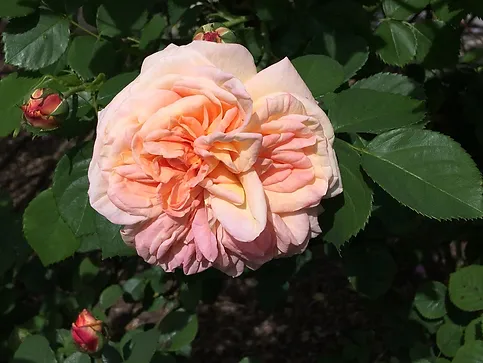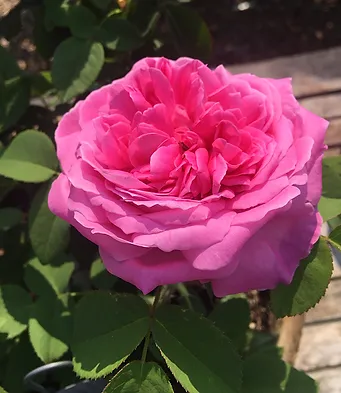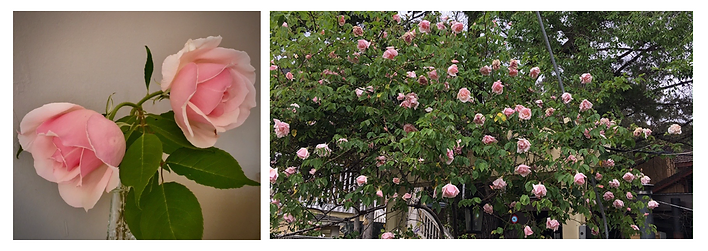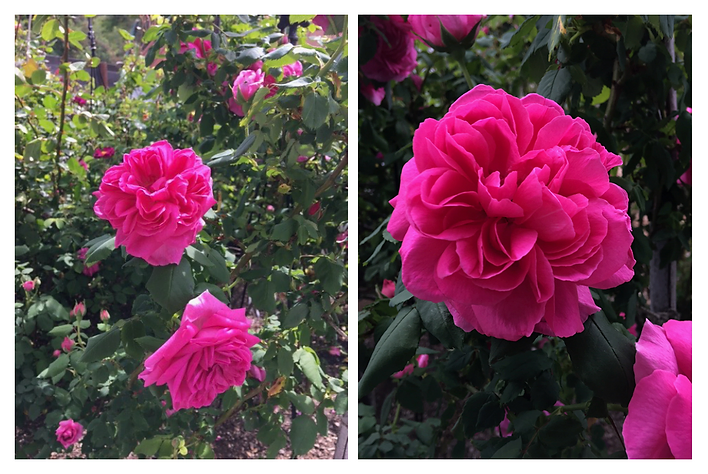by Joan Goff, Consulting Rosarian, Marin Rose Society
All photos submitted by Joan Goff
This is a 2006 Award of Merit article.

Now that I have been seriously growing roses for over 10 years I can say that I am hooked. Hooked on singles, hooked on old roses and really hooked on those once bloomers. I know a lot of you will say, “Oh, why grow a rose that only blooms once?” Well, I will tell you, when a once blooming rose blooms, it blooms! (LEFT: ‘The Alchemist’)
Once blooming roses are different from repeat bloomers in more ways than one. They will throw more buds which of course mean more blooms. They bloom longer than repeat bloomers and for the most part, their blooms last longer. A big exception is Alain Blanchard which the blooms only last about 3 days. Once bloomers also don’t all bloom at the same time. Some start as early as late April here in Marin County, but others start in May and some even don’t start until June. So here in Marin, you can have blooms from April to July with a once blooming rose.

Why are we so hard on a rose that only blooms once? Most other perennials also only bloom once and we don’t mind that a bit! Many of my favorite garden plants only bloom once. Daphne odora (winter daphne), night blooming jasmine, tulips, daffodils and most bulbs and so many other trees and perennials only bloom one time a year.
I now have seven varieties and nine plants of once bloomers: Alain Blanchard, Alchymist, Complicata, Duchesse de Montebello, La Belle Sultane, Leda and Rosa Glauca. (LEFT: ‘Yolande D’Aragon’)
Alain Blanchard, a hybrid gallica (1839) is a mauve semi double that is one of the most famous spotted roses. It is one of the most intensely spotted of all, with light crimson spots on a deep crimson-purple background. It has an ARS rating of 8.5. It is a knockout in every sense of the word. I fell in love with it from an article written by Linda and Ted Burg in the Criterion. I had to have it. I bought it bareroot in January 2001 and each year it gives me a few more blooms. It doesn’t grow very fast and its habit doesn’t lend itself to an upright…it forms a thicket of canes about 4 feet high and five feet wide. I have it against a fence and have tried to get it to grow upward and to tie it to the fence. The blooms only last about 3 days at best but oh what a sight!
Alchymist, A shrub introduced by Kordes in 1956. Although listed as a shrub, it makes a tall climber and can grow over 12 feet. The color is an apricot blend, very double and very fragrant. Parentage is ‘Golden Glow’ x Rosa elglanteria hybrid. ARS rating is 7.9.
Complicata, also a hybrid gallica with no certain date is probably the most famous of a once blooming single. ARS rating is 8.8. Nanette Londeree, in our society, has one plant that is about 12 feet wide and 8 feet tall and in bloom has literally thousands of blooms. It is a spectacular sight for about six weeks. The bloom is light pink with 5 petals and the stamens are bright yellow. I now have two plants, just having bought my second plant a few months ago. The first plant has only been in the ground for a year and a half and hopefully one of these years can match up to Nanette’s.
Duchess de Montebello, also a hybrid gallica was introduced by Laffay in 1824-25. The bloom is a double light pink with good fragrance. No ARS rating is given. I just bought this plant in 2005 at Heirloom in Oregon.
BELOW: Belle Portugaise

La Belle Sultane, also known as R.gallica violacea. It is supposed to have originated in Holland in the 1700’s or earlier. The bloom is a dark red crimson purple, almost single with 12 or so petals and bright yellow stamens. It has an ARS rating of 8.3. I planted my plant a year ago as a bare root and even though it has grown tremendously and now tops out at about 6 feet, it has not bloomed in my garden. I have high hopes for the blooms in 2006.
Addendum: In 2006, La Belle Sultane was the big winner in my garden: Not only did she put out over 150 blooms but she won Best of Show in the Marin Rose Society annual rose show. This rose is a super winner in every way. She also has NO disease in my organic garden.
Leda, damask, before 1867, is listed as a double white but it has a slight line of red crimson on the edges. Truly a unique looking rose. Its ARS rating is 8.3 but in my garden it does get some mildew. It doesn’t bother me as the mildew comes after the blooms are spent. So I just remove all of the leaves so the mildew doesn’t spread.
BELOW, LEFT ‘Souvenir de Victor Landeau’, RIGHT: ‘Souvenir du President Lincoln’

Rosa Glauca is my last and newest once bloomer rose. It is a species rose introduced about 1789 and also known as rosa rubrifolia with its foliage being the main attraction. In full sun the leaves take on a dusty mauve and in shade they turn a grayish mauve. Even the canes are a mauve color. The bloom is a single star shape and is dark pink on the outside with a whitish center. The blossoms are fragrant and followed by bright red hips that stay on the plant all winter. Very disease tolerant and the ARS rating is 8.8. This rose can grow to over 20 feet! Put it on the side of your house like I have or on a fence and combine with another climber that is a continuous bloomer to have a great look all season.
Have you noticed one of the common elements of the listed varieties? They all have ARS ratings of over 7.9! They won’t need spraying, they bloom like crazy and the bugs don’t like ‘em! I don’t know about you but in my garden this a big plus. Mix them in with your repeat bloomers and you will be as delighted as I am to have these spectacular roses in your garden and you won’t be disappointed at all that you only get blooms once a year.




























































